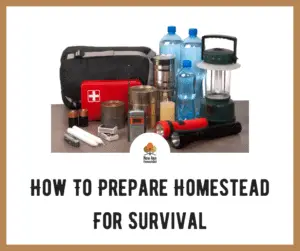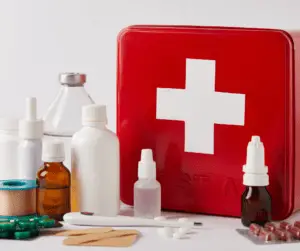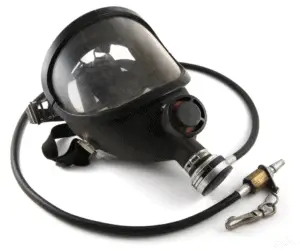If SHTF, you’ll want to make sure you and your homestead remain safe. Here’s an ultimate guide on how to do this; this way, even if the SHTF, you’ll be prepared to face it.
I’ve spent many years studying multiple SHTF scenarios, and one thing I’ve always paid attention to are homesteads; what happens if SHTF?
This concept is still a concern of mine, and it made me think, what can people do to maintain safety after a major disaster and protect the homestead?
These properties are built for families to live a self-sufficient life, but if the garden, livestock, and other necessary elements get destroyed when SHTF, what are you going to do?
This is why I’ve written this guide so that even after SHTF, you can stay rest assured that you and your homestead remain safe and secure.
In this guide, I will list a few critical things that can be done to help you shield your homestead. Keep in mind that we must prepare for all scenarios, not just one.
If you prepare for an EMP blast but avoid preparing for nuclear fallout, well, you’re not going to have a fun time if you survive the first day.
Let’s hop into it now.
10 Ways To Prepare Your Homestead For SHTF
1: Store Plenty Of Water
It should be no surprise that water storage comes in at number one. Water is crucial for survival, sure, but it should be noted that clean water can be tough to come by after SHTF.
To avoid dehydration after SHTF, you’ll need a large amount of water stored in an air-tight container, holding as much as you’re able to keep, don’t forget water sterilizing tablets too.
I would personally recommend that you store at least 100 gallons for each person to sustain for one month, more if you have livestock, at least for essential animals, like dogs or chickens.
I would also recommend that the water storage container is covered with a protective barrier away from anything that could puncture it.
You also need to recognize the possibility of contaminants in the water, be it fallout or other toxic elements that could find its way into the supply, which would inevitably lead to sickness.
Water Storage Checklist – Top 5
- Filtration Tablets
- Water Filters
- Storage Containers
- Livestock Water Storage
- Water Storage Protection
2: Grow Your Food Storage
This is the second most essential thing to keep in storage, especially if the garden or livestock doesn’t make it through the SHTF scenario.
I see many individuals who recommend beefing up (no pun intended) the homestead in terms of crops, livestock, etc. This is fine, but it’s not what will save you if you make it through that day.
Food storage is what should be a priority. The food that I would recommend in your storage would be anything high in protein, fats, and calories.
Perhaps consider storing a minimum of one month’s worth of food, preferably more. Food that you put in storage and do not plan to touch for a while should have an expiration date of 3-4 years out.
Here is a checklist of five great food items that are great energy producers and perfect for long-term storage.
Food Storage Checklist – Top 5
- Grains
- Canned Chicken
- Dehydrated Meats
- Canned Meats
- Various Spices
3: Have A Few Firearms
If there is one that has low competition in terms of being overpowered by a threat, it’s firearms.
They are instrumental in several ways; firearms can take down wildlife for food and provide immense protection for you, your family, livestock, and protect your assets.
I decided to add in the 30-30 because of its known reliability and its capability to penetrate brush and thick barriers easily.
I’ve shot many animals through thick brush successfully with a 30-30, 30-06 are great as well, but it may not successfully penetrate through a barrier as a 30-30 would.
A pistol is a must-have, but the shotgun and assault rifle is best used for closer range, although an assault rifle can undoubtedly be used for further shots than the pistol is capable of doing.
I’ve also added in a muzzleloader, they’re not necessarily the easiest to load, but a .50 caliber is a great buy nonetheless if you’re new to muzzleloaders.
Firearms Checklist – Top 5
- Long Gun: 30-30
- Shotgun: 12-Gauge
- Pistol: Glock-19
- Assault Rifle: AR-15
- Muzzleloader: .50 Caliber
4: Build A First-Aid Kit
No matter what else you have stocked up for surviving any SHTF scenario, it will not prove useful if you’re in no shape to put it to use.
A first-aid kit should include all the necessary items for most injuries, including antibiotics, otc pain relievers, bandages, tweezers, a thermometer, tourniquets, and peroxide, to name a few.
You should take into thought how many people the first-aid kit can support. Make sure it has enough supplies for each person that it’s intended to be used for.
If yourself or your family has asthma or any other health condition, consider putting back a week or so worth of medication, or ask your doctor if this is possible.
If you aspire to go even further, perhaps add in supply so that you can stitch a wound together, and consider throwing in a snake bite kit and an EpiPen.
First-Aid Kit Checklist – Top 5
- Antibiotics
- Tourniquets
- Peroxide
- Snake Bite Kit
- Bandages
5: Homestead Perimeter Security
One thing you should do to prepare for a SHTF scenario is to ensure your homestead is appropriately secured.
The first thing I’ll mention, which will be covered next, is a battery bank to assure the following recommendation can be powered in case of a power outage; camera systems.
If you place motion detecting security cameras around your property, you will be alerted of any movement.
Very sturdy and tall metal or aluminum double fencing that is 12 feet or more is recommended to prevent most break-ins to the property, perhaps by also adding razor wire at the top.
You can also add spike belts surrounding the property and even adopt a few guard dogs like the Caucasian Shepherd or Kangal to defend against intruders, both human and animal.
You may also like the idea of posting signage that there are traps scattered throughout the property. This may very well make someone think twice about trespassing after SHTF.
Homestead Security Checklist – Top 5
- Security Camera
- Guard Dogs
- Double Fencing
- Razor Wire
- Spike Belts
6: Have A Few Power Banks
I can’t stress enough how vital power banks are after a SHTF scenario. Many preppers avoid relying on electronics, which is excellent; I highly agree with this.
However, just because electronics aren’t good to rely on, they’re great to have, that’s for sure. The perfect example of what can be powered by a power bank is HAM radios.
You may also find the power bank useful for a GPS, heater, smartphone, or lighting, especially if the fire is hard to start due to rain, snow, etc.
I wouldn’t recommend just any power bank, though. If you do elect to purchase one, then only buy one that can be powered via solar or crank, whether it be built-in or addable.
You may not have the ability to recharge the power bank if there is no commercial power available.
If you plan to ride out a SHTF scenario on your homestead, you’d be better off going with a larger capacity battery bank, especially if you want to use it for more than just surviving.
Power Banks Checklist – Top 5
- Solar Battery Bank
- Jackery Portable Bank
- WindyNation Solar/Battery Kit
- 62,000MaH Battery Bank
- Foldable Solar Panel
7: Protection From EMPs
If you want to retain the ability to use electronics after an EMP is detonated, then there are a few elements you can do to give your electronics a much higher chance of survival.
EMPs are short for “Electromagnetic Pulse,” which can be emitted by either the sun caused by a solar storm or a nuclear bomb detonated high into our atmosphere.
These weapons are not dangerous to humans directly, but they can fry any electronics in its path.
To prevent this, you’ll need what is called a Faraday bag. These are special types of bags that prevent signals from going in and out of the bag.
They also help reduce or completely diminish an EMPs chances of penetrating through the bag, keeping any electronics inside safe.
If you have anything that’s powered via AC, then you’ll need ferrite clip-on beads, which are used to prevent the electronics from surging over maximum operating levels.
I recommend that you purchase any electronics that you believe will be useful after SHTF and place them inside of the bag, as you may not have enough time to save your on-person cache.
EMP Protection Checklist – Top 5
- Faraday Bag
- Ferrite Clip-On Beads
- Faraday Cages
- Wrap It All In Aluminum Foil
- Foil Should Be 3-5 Layers
8: Nuclear Fallout Protection
The most commonly talked about SHTF scenario among preppers are nuclear attacks, which would undoubtedly devastate the United States.
When a nuclear bomb is detonated, a large explosion occurs at ground zero, followed by an overwhelmingly large mushroom cloud, leading to fallout.
The fallout falls like snow for up to hundreds of miles away, not to mention the radiation that comes with it all.
To prepare your homestead, make sure each door and window is completely sealed when shut. If you have livestock, consider putting them inside a barn if a nuclear blast is possible.
If you outlive the initial blast, the fallout is on its way, and quickly. Go inside and shut every possible entrance, and place wet towels over each window and door seal to further help seal them.
If you get any fallout on you, immediately take your clothes off, followed by a shower.
Radiation is next, so consider buying a Geiger Counter to test radiation levels live; PPE is excellent to protect you from radiation, which will be covered further in the article.
Nuclear Fallout Checklist – Top 5
- Seal All Doors/Windows
- Walk Livestock Into Barn
- Purchase a Geiger Counter
- Stock Up On PPE
- Bathe If Fallout Touches You
9: Protecting The Livestock
If your homestead has more than just a few chickens, such as cows, goats, or pigs, then there are a few great measures you can take to raise their chances of survival.
No one can guarantee the survival of livestock, especially if the SHTF scenario in question is nuclear war because saving them from fallout and radiation would be nearly impossible.
Despite this, the least we can do is try, right? For starters, you’ll want to make sure you have at minimum a few weeks’ worths of food and water that is both air and watertight.
This will prevent contaminants from entering the food and water supply. Next, you should consider a barn that is as air-tight as possible, even though this may be difficult without a doubt.
You could perhaps dig a trench that is seven to twelve feet deep and easily accessible, allowing the livestock to walk in to avoid direct hits from the blast, although this will undoubtedly be a chore.
Smaller animals can be brought inside, but the larger animals will have to play mostly by luck, although taking these precautions will help and do not forget a first-aid kit for the livestock.
Livestock Protection Checklist – Top 5
- 30 Days Of Food
- Trenches
- Barn
- 30 Days Of Water
- Animal First-Aid Kit
10: Have Plenty Of PPE (Personal Protection Equipment)
If you want to stand a chance facing a nuclear weapon, which if you survived the blast, you’d have to deal with radiation and fallout, then you’ll need PPE.
These are used to avoid ingesting harmful substances and other toxicities. Typically these are in the form of masks, although there are hazmat suits, goggles, and more.
For the radiation, you’ll need a proper mask, suit, and ensure that everything is as airtight as possible.
You should also have earplugs to avoid anything seeping into the ear canal and gloves to prevent touching dangerous substances like fallout.
N95 masks are critical to have in any pandemic, and if the virus is dangerous enough, a hazmat suit is not a stretch.
PPE Checklist (Personal Protection Equipment) – Top 5 Options
- Hazmat Suit
- N95 Masks
- Earplugs
- Gas Masks
- Goggles
Survival Checklist – 25 More Must-Have Items
- Canning System
- Matches
- Survival Knives
- Batteries
- Ammo
- Seeds
- Fuel
- Flashlights
- Portable Stove
- Crank Radio
- Survival Blanket
- Candles
- Multitool
- Bleach
- Rope
- Iodine Tablets
- Fishing Kit
- Zip Ties
- Oil Burning Lamp
- Generator
- Livestock Care Book
- Local Maps
- Survival Gloves
- Stitching Kit
- Antibacterial
Open Questions
What Skills Are Most Critical To Learn?
The number one skill everyone should know is water purification. Clean water may be a rare find after SHTF, and without it, you can’t survive.
General knowledge of shelter building is also a good skill to know because you may not be able to shelter in your homestead; it’s good to have options.
First-aid is just as crucial as water purification as if you get injured and lack the necessary skills to treat yourself; all other preps go out of the window.
Should I Build A Bug-Out-Bag?
I see no reason why seeking shelter on a homestead isn’t adequate for most SHTF scenarios.
However, if you do have a reason to bug out and lack an easily accessible gear bag, you may not make it far.
This is why I agree that a bug out bag is critical for anyone to have, a homesteader or not. If you have family, make sure they each have their own as well.
Which SHTF Scenarios Are Most Likely?
There is no certainty as to which SHTF scenario will happen, but there are a few that stick out to me as a prepper.
A deadly pandemic, something to the likes of Ebola, but airborne, is something to be concerned about, following EMPs, both of which have a higher possibility than others.
Nuclear warfare, solar flares, major earthquakes, supervolcanic eruptions are things that probably won’t happen but could, so it’s best to prepare.
Verdict
If you own a homestead, or perhaps you’re a novice prepper that is trying to learn more about how to survive the apocalypse, then this article should point you in the right direction.
Homesteads are self-sufficient and are often equipped to handle most minor disasters, mainly because of solar power and water storage.
These won’t be of much help, more specifically if they’re not set up to handle a real SHTF scenario. In a SHTF situation, you run a few risks.
If you implement these tips into your plan, your chances of surviving the big day will skyrocket.
As the saying goes, “id rather be prepared and not need it than not be prepared and need it.”



